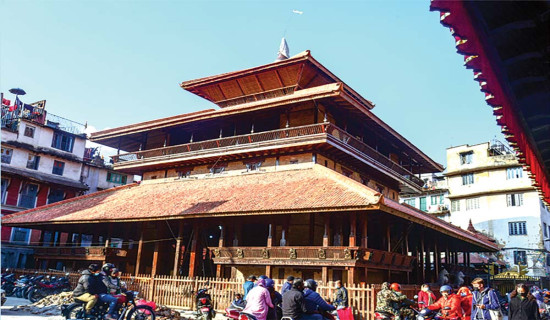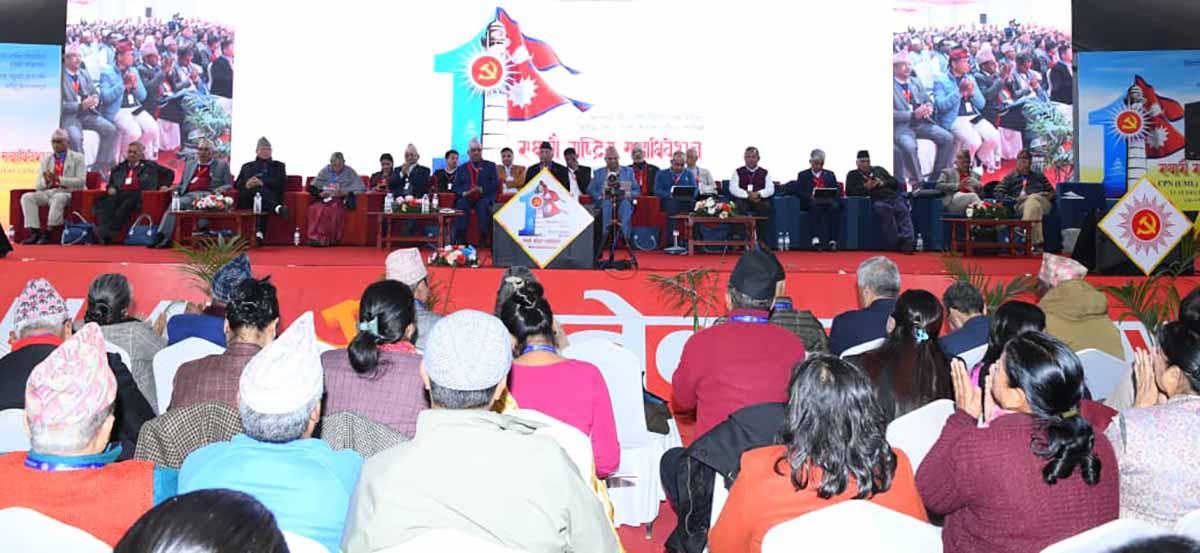- Monday, 15 December 2025
Restoration of Lichchhavi era Yanga Hiti underway
Traditional Hitis (stone spouts) which were concealed under bushes, shrubs, and water are now being restored to their former glory thanks to the Bagmati Province government and Yanga Hiti Renovation Programme Consumer Committee.
Rickety NSU building a shabby show years after earthquake
Kathmandu, June 28: Owners of the curio and other shops which are in operation in the open-air souvenir market of Basantapur Dabali near the rickety building of the liaison office of the Nepal Sanskrit University (NSU) have been in constant fear for nine years after the Gorkha Earthquake in 2015. The building used by the NSU developed multiple cracks in the massive earthquake. Basantapur Dabali, an open area adjacent to Hanumandhoka Durbar Square, is always crowded with domestic and foreign tourists. But the NSU building standing to the south of the Hanuman Dhoka in support of several logs not only poses a threat but also is an eyesore to the tourists visiting the World Heritage Site (WHS) every day. Because of the negligence shown on the part of the relevant institutions and stakeholders, the rickety white building standing in the World Heritage Site (WHS) has not been demolished even nine years after the earthquake. As a result, the four-and-a half-storey damaged structure still stands in support of 14 logs in the heart of the capital city. Macharaja Maharjan, Ward Chairperson of Ward No. 23 of Kathmandu Metropolitan City (KMC), said that currently they had no plan to reconstruct or pull down the building. The metropolis had earlier decided to demolish the building through the ward but did not allocate any budget for that. It seems that the metropolis is not serious about the risky building, he said. Maharjan said, “We have demanded the allocation of the required budget to demolish the building, and the demolishing process will begin from the coming fiscal year if the KMC allocates the budget. Otherwise, we cannot say anything about this building.” “We need to exert pressure if the metropolis does not allocate budget in the coming fiscal year,” he said. He further said that the adjoining building used by Nawa Aadarsha Secondary School would also be demolished together with the NSU building if the KMC allocated the budget. The school had already been shifted to the buildings of another community school. Saubhagya Pradhananga, Director General of the Department of Archeology (DoA), said that earlier the metropolis proposed to the DoA to demolish the building but it rejected citing a lack of manpower. The DoA has prepared a drawing design of the new building for the metropolis to reconstruct it in its original shape after demolishing the old structure. The DoA will keep only inventory records of the building, she said.It seems the main stakeholder, Nepal Sanskrit University, has not paid any attention to take care of its liaison office. The office had been shifted to its central office in Beljhundi, Dang, after the building was damaged by the earthquake. Before the ratification of the NSU Act in 1986, the building was under the ownership of Tribhuvan University (TU). After the introduction of the Act, TU handed over the building to the NSU, which has its central office in Beljhundi, Dang, Lumbini Province, to use it as its liaison office in Kathmandu and a research centre.However, according to the Sanskrit University, TU has handed over the ownership only orally, not legally. This means that even though NSU has been using the building for the past 35 years, the land is registered under TU’s name. The NSU says it cannot move forward with the reconstruction process because of the issue of legality of ownership while TU says that NSU is solely responsible for the building and its renovation because it has been using it since the 1980s.Because of this dispute, neither university has taken any initiative to begin rebuilding the severely cracked building nor have they made any effort to manage funds for it.
Most heritages destroyed by 2015 quake restored
Even nine years after the devastating earthquake of April 25, 2015, reconstruction of a few destroyed heritages is yet to be completed or begun. Some heritage monuments of the World Heritage Sites of the Kathmandu Valley and other places have not yet been reconstructed because of the carelessness of the local bodies, disputes with the contractors and problems within the consumer committees.
Gahana Khojne Jatra marked with much fanfare
A large number of people gathered at Gahana Pokhari of Handigaun to enjoy the Gahana Khojne Jatra (searching for the jewel fiesta) on Wednesday. The chariot of Tundal Devi
Seto Machhindranath chariot procession to begin today
The three-day chariot procession of Seto Machhindranath is being started on Tuesday with the chariot being pulled from Tindhara Pathsala. The chariot is being pulled from Tindhara Pathsala to Ghantaghar, and women and tourists too are expected to pull the chariot this year.
Shrestha pierces tongue for 2nd time
Sujan Baga Shrestha, a resident of Khasi, Bode, Madhyapur Thimi, has pierced his tongue for the second time to commemorate the tongue piercing festival held on Sunday. Aiming to preserve the dying culture, the 28-year-old Shrestha of Bode Ward No 8 has been performing the tongue-piercing act since last year. Shrestha's tongue was pierced with a 10-inch long iron needle today.
Vatsaleshwori Jatra of Pashupati underway
Vatsaleshwori Jatra, one of the longest jatra celebrated in the Pashupati area started on Friday. The Jatra is being held in the Pashupatinath area wishing for peace in the country. The Jatra is performed in Vatsaleshwori Temple four days after Dudu Chya Chya (invitation journey) by Amalkot Kachahari.
Sujan Bagh piercing tongue for second time
Sujan Bagh Shrestha is going to pierce his tongue on April 14 for the second time during the famous tongue-piercing festival of Bode in Madhyapur Thimi, Bhaktapur district. Sujan, a 28-year-old resident
Intersex persons face ordeals in getting jobs
A few newborn babies do not fit the typical definition of a male or female. Though such a case is rare, such children face problems as they grow up. Esan Regmi of Bajura was born as a female. “When I was born, my parents raised me as a daughter,” Regmi, an intersex activist, recalled.
Previous police office in capital’s heart standing as eyesore
It has been almost nine years since the devastating earthquake rocked Nepal on April 25, 2015. Over the years, many of the damaged houses and monuments have stood erect and restored to their former glory while several others are undergoing reconstruction.
KMC building Phalchas at bus stops
Kathmandu Metropolitan City (KMC) is going to construct traditional resting places indigenously known as ‘Phalchas’ at the bus stops of the metropolis. For now, 10 Phalchas will be built by the metropolis in the main crowded areas.
Kids supposed to play compelled to toil away
Nita, a resident of Melamchi (name changed), was forced to take up work at a small tea shop in Jorpati, Kathmandu before she was even a teenager. When Nita was only 12 years old, her father left
Dwarf Association seeks land to build village for them
Inspired from the Amar Village of Assam, India, and similar settlements in other nations, short-statured people in Nepal are demanding a separate village for themselves to live with love and dignity.
Preservation of Sundhara sees no progress
The magnificent golden spout Sundhara used to be an unparalleled work of water engineering in the Kathmandu Valley. But it dried up in 2005, in course of the construction of the present-day Kathmandu Mall building.
Ownership dispute delays university liaison office reconstruction
The four-and-a-half-storey liaison office of the Nepal Sanskrit University (NSU) at Basantapur still stands in support of multiple logs, more than eight years after it was violently shaken by the devastating Gorkha earthquake.

















